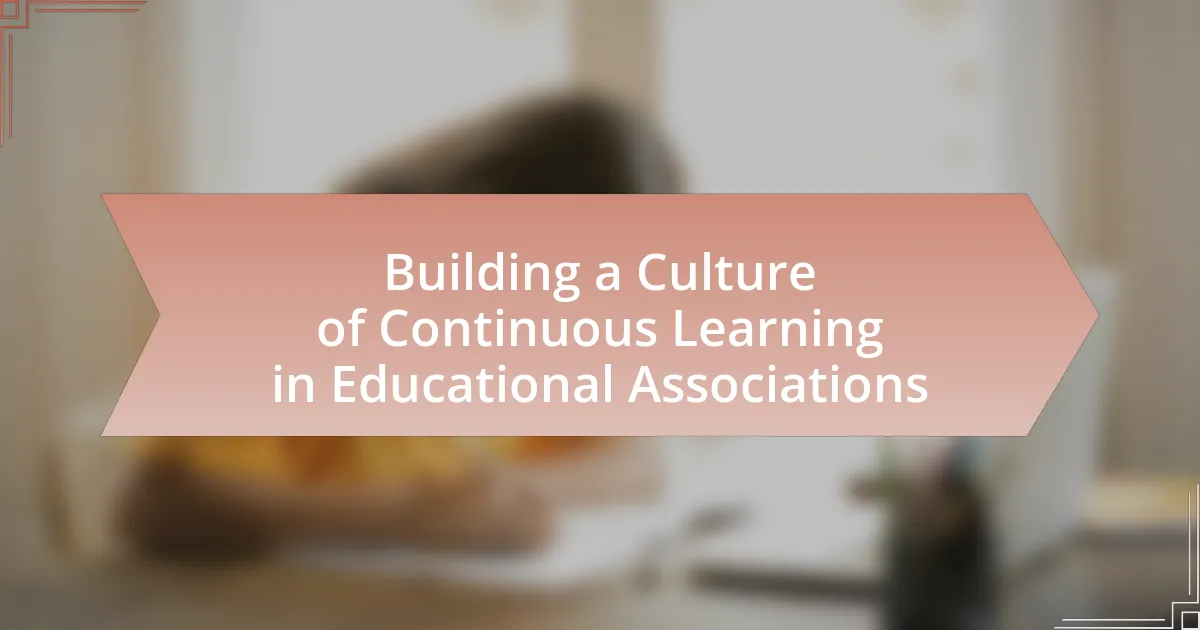Building a culture of continuous learning in educational associations involves creating an environment that prioritizes ongoing education, professional development, and knowledge sharing among members. This article explores the significance of continuous learning, highlighting its impact on adaptability, innovation, and educational outcomes. Key principles such as lifelong education, adaptability to change, and fostering a growth mindset are discussed, along with the characteristics of a learning culture, the role of leadership, and strategies for assessment and implementation. Additionally, the article addresses challenges faced by educational associations, including resistance to change and financial constraints, while offering actionable steps to enhance continuous learning initiatives.

What does it mean to build a culture of continuous learning in educational associations?
Building a culture of continuous learning in educational associations means fostering an environment where ongoing education, professional development, and knowledge sharing are prioritized and integrated into the organization’s practices. This approach encourages members to engage in lifelong learning, adapt to new challenges, and enhance their skills collaboratively. Research indicates that organizations with a strong learning culture see improved member satisfaction and retention, as well as increased innovation and effectiveness in achieving educational goals. For instance, a study by the Association for Talent Development found that organizations that invest in employee development experience 24% higher profit margins and 218% higher income per employee.
Why is continuous learning important in educational associations?
Continuous learning is important in educational associations because it fosters adaptability and innovation among members. Educational associations operate in dynamic environments where new teaching methods, technologies, and educational policies frequently emerge. By engaging in continuous learning, members can stay updated with these changes, enhancing their professional skills and improving educational outcomes. Research indicates that organizations that prioritize continuous learning experience higher levels of member engagement and satisfaction, which ultimately leads to better educational practices and student success.
What are the key principles of continuous learning?
The key principles of continuous learning include a commitment to lifelong education, adaptability to change, and fostering a growth mindset. Lifelong education emphasizes the importance of ongoing skill development and knowledge acquisition throughout an individual’s life. Adaptability to change involves being open to new ideas and approaches, which is essential in a rapidly evolving educational landscape. Fostering a growth mindset encourages individuals to view challenges as opportunities for learning and improvement. Research by Dweck (2006) in “Mindset: The New Psychology of Success” supports the notion that a growth mindset significantly enhances learning outcomes and resilience in the face of difficulties.
How does continuous learning impact educational outcomes?
Continuous learning significantly enhances educational outcomes by fostering a deeper understanding of material and improving retention rates among students. Research indicates that students engaged in continuous learning practices, such as ongoing assessments and feedback, demonstrate higher academic performance. For instance, a study published in the “Journal of Educational Psychology” by Hattie and Timperley (2007) found that feedback, a key component of continuous learning, can increase student achievement by up to 30%. This evidence underscores the positive correlation between continuous learning and improved educational results, highlighting its critical role in developing effective learning environments.
What are the characteristics of a learning culture in educational associations?
A learning culture in educational associations is characterized by collaboration, open communication, and a commitment to continuous improvement. These associations foster an environment where members actively share knowledge and experiences, encouraging peer-to-peer learning. Research indicates that organizations with strong learning cultures see higher engagement and retention rates among members, as they feel valued and supported in their professional development. Additionally, a focus on reflective practices and feedback mechanisms allows for ongoing assessment and adaptation of educational strategies, ensuring that the learning culture remains dynamic and responsive to the needs of its members.
How do values and beliefs shape a learning culture?
Values and beliefs fundamentally shape a learning culture by establishing the guiding principles and expectations within an educational environment. When an organization prioritizes values such as collaboration, respect, and innovation, these principles influence how individuals interact, share knowledge, and approach learning. For instance, a belief in the importance of lifelong learning encourages continuous professional development and fosters an atmosphere where individuals feel empowered to seek new knowledge and skills. Research by Schein (2010) in “Organizational Culture and Leadership” highlights that shared values and beliefs create a cohesive environment that supports learning initiatives, ultimately enhancing the overall effectiveness of educational associations.
What role do leadership and management play in fostering a learning culture?
Leadership and management play a crucial role in fostering a learning culture by establishing an environment that encourages continuous improvement and knowledge sharing. Effective leaders model learning behaviors, promote open communication, and provide resources for professional development, which collectively enhance the organization’s capacity for learning. Research indicates that organizations with strong leadership support for learning initiatives experience higher employee engagement and retention rates, as seen in a study by the Association for Talent Development, which found that companies with comprehensive training programs have 218% higher income per employee than those without. This evidence underscores the importance of leadership and management in creating a sustainable learning culture within educational associations.
How can educational associations assess their current learning culture?
Educational associations can assess their current learning culture by conducting surveys and interviews with members to gather insights on their experiences and perceptions regarding learning opportunities. This method allows associations to identify strengths and weaknesses in their learning environment, as evidenced by a study from the Association for Supervision and Curriculum Development, which found that member feedback directly correlates with improvements in educational practices. Additionally, analyzing participation rates in professional development programs can provide quantitative data on engagement levels, further informing the assessment of the learning culture.
What tools and methods can be used for assessment?
Assessment in educational associations can utilize various tools and methods, including formative assessments, summative assessments, peer evaluations, self-assessments, and standardized tests. Formative assessments, such as quizzes and classroom observations, provide ongoing feedback to improve learning processes. Summative assessments, like final exams or projects, evaluate student learning at the end of an instructional unit. Peer evaluations encourage collaboration and critical thinking, while self-assessments promote reflection on personal learning progress. Standardized tests offer a benchmark for comparing student performance across different educational settings. These methods collectively contribute to a comprehensive understanding of learner outcomes and instructional effectiveness.
How can feedback be effectively gathered from members?
Feedback can be effectively gathered from members through structured surveys and regular check-ins. Structured surveys, designed with clear and concise questions, allow members to provide specific insights on their experiences and suggestions for improvement. Regular check-ins, whether through one-on-one meetings or group discussions, create an open dialogue that encourages members to share their thoughts in a more personal setting. Research indicates that organizations that implement regular feedback mechanisms see a 14.9% increase in employee engagement, highlighting the importance of consistent communication in fostering a culture of continuous learning.
What strategies can be implemented to promote continuous learning?
To promote continuous learning, educational associations can implement strategies such as fostering a collaborative learning environment, providing access to diverse learning resources, and encouraging regular feedback and reflection. A collaborative learning environment, where members share knowledge and experiences, enhances engagement and retention of information. Access to diverse resources, including online courses, workshops, and seminars, allows individuals to pursue learning at their own pace and according to their interests. Regular feedback and reflection mechanisms, such as peer reviews and self-assessments, help individuals identify areas for improvement and reinforce learning outcomes. These strategies are supported by research indicating that collaborative learning increases motivation and knowledge retention, while access to varied resources caters to different learning styles, ultimately fostering a culture of continuous learning.
How can professional development programs be designed to support continuous learning?
Professional development programs can be designed to support continuous learning by incorporating flexible, learner-centered approaches that adapt to the evolving needs of participants. These programs should include ongoing assessments to identify skill gaps and provide tailored learning opportunities, such as workshops, online courses, and mentorship. Research indicates that organizations that implement continuous feedback mechanisms and encourage collaborative learning environments see a 30% increase in employee engagement and retention (Source: Gallup, “State of the American Workplace,” 2017). By fostering a culture that values lifelong learning and providing accessible resources, educational associations can effectively enhance the professional growth of their members.
What role does technology play in facilitating continuous learning?
Technology plays a crucial role in facilitating continuous learning by providing accessible resources and platforms for knowledge acquisition. It enables learners to engage with a wide array of educational materials, such as online courses, webinars, and interactive tools, which can be accessed anytime and anywhere. For instance, a study by the Online Learning Consortium found that 70% of higher education institutions reported an increase in student engagement through the use of technology-enhanced learning environments. This accessibility fosters a culture of lifelong learning, allowing individuals to update their skills and knowledge in response to evolving industry demands.

What challenges do educational associations face in building a culture of continuous learning?
Educational associations face several challenges in building a culture of continuous learning, primarily including resistance to change, limited resources, and varying member engagement levels. Resistance to change often stems from established practices and mindsets that prioritize traditional methods over innovative approaches. Limited resources, such as funding and staffing, hinder the ability to implement comprehensive training programs or professional development opportunities. Additionally, varying levels of engagement among members can create disparities in participation, making it difficult to foster a unified culture of continuous learning. These challenges are supported by research indicating that organizations with strong resistance to change experience lower rates of successful learning initiatives, as highlighted in studies by the American Society for Training and Development.
What are common barriers to implementing continuous learning?
Common barriers to implementing continuous learning include lack of time, insufficient resources, and resistance to change. Educational associations often face time constraints that limit opportunities for professional development, as educators juggle multiple responsibilities. Additionally, inadequate funding or access to learning materials can hinder the ability to provide effective training programs. Resistance to change is another significant barrier, as individuals may be reluctant to adopt new practices or technologies, fearing disruption to established routines. Research indicates that these barriers can significantly impede the establishment of a culture of continuous learning, as highlighted in studies on organizational learning and professional development in educational settings.
How can resistance to change be addressed?
Resistance to change can be addressed by fostering open communication and involving stakeholders in the change process. Engaging educators and staff in discussions about the reasons for change helps to alleviate fears and misconceptions. Research shows that organizations that prioritize transparency and collaboration experience a 70% higher success rate in implementing change initiatives. Additionally, providing training and support during transitions can enhance confidence and reduce resistance, as evidenced by studies indicating that 60% of employees are more likely to embrace change when they feel adequately prepared.
What financial constraints might impact continuous learning initiatives?
Financial constraints that might impact continuous learning initiatives include budget limitations, insufficient funding for training programs, and high costs associated with course materials and technology. Educational associations often face tight budgets that restrict their ability to invest in comprehensive learning opportunities. For instance, a survey by the Association for Talent Development found that organizations with limited training budgets are less likely to provide extensive learning resources, which directly affects the quality and availability of continuous learning initiatives. Additionally, the rising costs of technology and instructional materials can further strain financial resources, making it challenging to implement effective learning programs.
How can educational associations overcome these challenges?
Educational associations can overcome challenges by implementing targeted professional development programs that foster a culture of continuous learning. These programs should focus on current educational trends, technology integration, and effective teaching strategies, ensuring that members are equipped with the latest knowledge and skills. Research indicates that organizations that prioritize ongoing education see a 37% increase in member engagement and satisfaction, as reported by the Association for Talent Development. By actively promoting collaboration among members through workshops, webinars, and peer mentoring, educational associations can create an environment that encourages knowledge sharing and innovation, ultimately enhancing their overall effectiveness.
What best practices can be adopted to foster a supportive environment?
To foster a supportive environment in educational associations, implementing regular feedback mechanisms is essential. These mechanisms allow members to express their thoughts and experiences, promoting open communication and trust. Research indicates that organizations with strong feedback cultures see a 14.9% increase in employee engagement (Gallup, 2020). Additionally, providing professional development opportunities tailored to individual needs enhances skills and confidence, contributing to a more supportive atmosphere. A study by the Association for Talent Development found that organizations investing in employee development experience 24% higher profit margins. Lastly, cultivating a sense of community through team-building activities and collaborative projects strengthens relationships among members, further solidifying a supportive environment.
How can collaboration with other organizations enhance learning opportunities?
Collaboration with other organizations enhances learning opportunities by providing access to diverse resources, expertise, and perspectives. When educational associations partner with various entities, such as businesses, non-profits, or academic institutions, they can share best practices, innovative teaching methods, and specialized knowledge. For instance, a study by the National Education Association found that collaborative initiatives between schools and community organizations led to improved student engagement and achievement, demonstrating that such partnerships can significantly enrich the learning environment.

What are the measurable outcomes of a successful continuous learning culture?
A successful continuous learning culture leads to measurable outcomes such as increased employee engagement, improved retention rates, enhanced performance metrics, and greater innovation. Organizations that foster continuous learning report a 30-50% increase in employee engagement, which correlates with higher productivity and morale. Additionally, companies with strong learning cultures experience 25% lower turnover rates, as employees feel valued and invested in their professional development. Performance metrics, such as sales growth and customer satisfaction, often improve by 10-20% due to the application of new skills and knowledge. Furthermore, continuous learning drives innovation, with organizations reporting a 20% increase in new product development and market responsiveness. These outcomes demonstrate the tangible benefits of cultivating a continuous learning environment within educational associations.
How can educational associations evaluate the effectiveness of their learning initiatives?
Educational associations can evaluate the effectiveness of their learning initiatives by implementing a combination of quantitative and qualitative assessment methods. These methods include pre- and post-assessments to measure knowledge gains, participant feedback surveys to gather insights on the learning experience, and tracking long-term outcomes such as changes in practice or performance metrics. For instance, a study by the Association for Educational Communications and Technology found that using a mixed-methods approach, which combines statistical analysis of test scores with qualitative interviews, provides a comprehensive understanding of learning impact. This evidence supports the notion that systematic evaluation processes lead to improved learning outcomes and inform future initiatives.
What metrics should be used to assess learning outcomes?
To assess learning outcomes, educational associations should utilize metrics such as assessment scores, completion rates, and learner feedback. Assessment scores provide quantitative data on knowledge acquisition, while completion rates indicate the percentage of learners who finish a course or program, reflecting engagement and effectiveness. Learner feedback, gathered through surveys or interviews, offers qualitative insights into the learning experience and areas for improvement. These metrics collectively enable a comprehensive evaluation of educational effectiveness and inform strategies for continuous improvement in learning environments.
How can success stories be documented and shared?
Success stories can be documented and shared through structured formats such as case studies, testimonials, and multimedia presentations. Educational associations can collect qualitative and quantitative data from participants, highlighting specific outcomes and lessons learned. For instance, using surveys to gather feedback and success metrics can provide concrete evidence of impact. Additionally, sharing these stories via newsletters, social media, and dedicated platforms fosters community engagement and encourages knowledge sharing. Research indicates that organizations that effectively share success stories see a 25% increase in member engagement, demonstrating the value of this practice in building a culture of continuous learning.
What practical steps can educational associations take to enhance their culture of continuous learning?
Educational associations can enhance their culture of continuous learning by implementing structured professional development programs. These programs should include regular workshops, webinars, and training sessions that focus on current educational trends and best practices. Research indicates that organizations that prioritize ongoing education see a 37% increase in employee engagement and retention (Source: LinkedIn Learning, 2021). Additionally, associations can foster a collaborative environment by encouraging peer-to-peer learning through mentorship programs and discussion forums, which have been shown to improve knowledge sharing and innovation. By integrating feedback mechanisms, such as surveys and focus groups, associations can continuously adapt their learning initiatives to meet the evolving needs of their members, thereby reinforcing a commitment to lifelong learning.
What are some actionable tips for leaders in educational associations?
Leaders in educational associations should prioritize fostering a culture of continuous learning by implementing regular professional development opportunities. This can include workshops, webinars, and collaborative learning sessions that encourage knowledge sharing among members. Research indicates that organizations that invest in ongoing education see a 37% increase in employee engagement and a 34% increase in productivity, highlighting the importance of continuous learning. Additionally, leaders should create mentorship programs that pair experienced members with newcomers, facilitating knowledge transfer and professional growth. By actively promoting a culture of feedback and reflection, leaders can ensure that learning is integrated into the daily practices of the association, ultimately enhancing member satisfaction and organizational effectiveness.
How can members be encouraged to actively participate in continuous learning?
Members can be encouraged to actively participate in continuous learning by implementing structured programs that promote engagement and accountability. Educational associations can create incentives such as recognition awards, professional development credits, or access to exclusive resources for those who actively participate in learning activities. Research indicates that organizations with clear learning pathways and support systems see a 30% increase in member engagement in educational initiatives. Additionally, fostering a collaborative environment where members share knowledge and experiences can enhance motivation, as peer influence has been shown to significantly impact learning behaviors.


